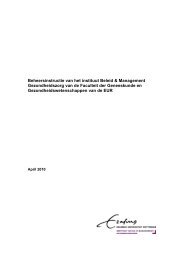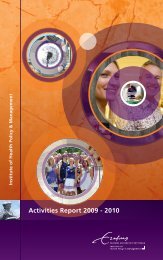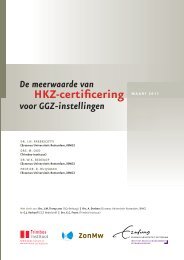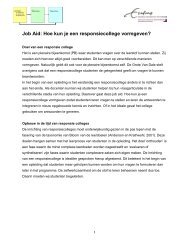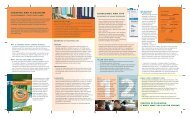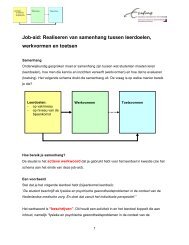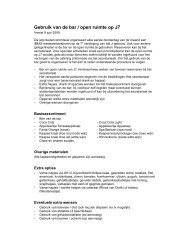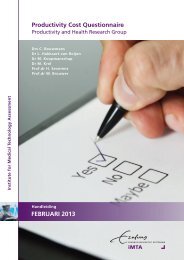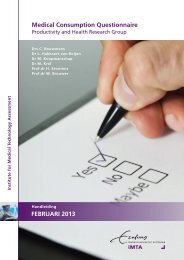132Chapter 8treating ARM (cost per QALY of € 2,482), treating CDH (cost per QALY of€ 2,434), and ECMO (cost per life-year of € 3,153 and € 697 in CDH and MASrespectively) is beyond a doubt (see Chapters 2, 3, and 5).Then however, the decision maker may argue that health policy making entailsmore than simply ranking cost-effectiveness ratios. Indeed, this thesis recognizedthat the cost-effectiveness criterion deserves to be given weight, but in almost allpolicy processes other priority criteria should play important roles (Chapter 7).There are bound to be some cases in which there are compelling reasons foradopting a technology even when the cost-effectiveness criterion is not satisfied,or for rejecting a technology even when it is. Chapter 7 noted that especiallyequity, which is concerned with the fair distribution of health and health care,needs to be taken into account in health care policy making. In that chapter itwas also observed that decision makers and the public seem to place greateremphasis on equity than is currently reflected by cost-effectiveness analysis (i.e.,the traditional QALY maximization approach).Here arises the issue of why decision makers may still be reluctant to use costeffectivenessanalyses. Of course, there are many factors explaining why suchanalyses currently seem to have a modest impact on health care decisionmaking. 17-20 Among these may be fundamental misunderstandings about resourceconstraints, a perceived lack of relevance, or a mistrust of the methods amongdecision makers as well as physicians, coupled with the public's deep-seateddistaste of limits. 12 Yet, the concern that cost-effectiveness analysis may lead toan allocation of limited resources that is inequitable seems an important factorhindering the acceptance of cost-effectiveness analysis. If decision makers,together with researchers, would succeed in finding ways to capture these equityconcerns, this would considerably enlarge the potential impact of costeffectivenessanalyses. As clarified in Chapter 7, many of the equity approachespresently put forward appeared to focus on age or disease severity, and give highpriority to treating the youngest or the sickest patients. Chapter 7 demonstratedat the same time that diverse authors brought up diverse equity approaches,resulting in partly different outcomes of the priority setting process. Which equityapproach is morally most defensible and most consistent with societal values andpreferences, is far from being a settled issue. There are more questions thananswers at this stage. It is an important responsibility for decision makers tomake choices regarding the best way to encapsulate equity concerns in economicevaluation, a responsibility that they will have to take on with the help ofresearchers, and building on the results of further public opinion surveys on thetrade-off between equity and cost-effectiveness criteria.
General Discussion: A Guided Tour Providing Four Different Views of the Results 1338.5 PERSPECTIVE 4: THE HEALTH ECONOMICS RESEARCHERWe have covered most of our tour. The final view offered is the perspective of thehealth economics researcher. Looking at the results of this thesis from a researchperspective, it attracts attention that evidence on the cost-effectiveness ofneonatal surgery was largely lacking in the past, and, to a lesser extent, still is.In Chapter 1, a review by Stolk and colleagues was cited to show that evidencewas still rudimentary in the year 2000. 21 The studies presented in this thesis andsome other studies brought expansion, but on the whole current evidenceremains limited (Chapter 7). Extending the evidence base on the conditionsstudied in this thesis (ARM, CDH, and, much less, MAS) would be welcome,because, as one reason, the studies in this thesis involved only one country andonly one, sometimes two, pediatric centers. Further evidence is all the moreneeded for the other neonatal surgical diseases, about which this thesis couldonly hypothesize. Apart from this, economic evaluation is not a one-timeexercise, but should be an ongoing effort. Changing patterns of disease andinnovations in treatments may render a once cost-effective technology less costeffective.As Chapter 7 discussed, it is not obvious that current favorable costeffectivenessratios in neonatal surgery will remain unchanged. To give anexample: when new alternative treatment modalities, such as exogenoussurfactant therapy, high-frequency oscillatory ventilation, and inhaled nitric oxide,evolve further, this will have an effect on the cost-effectiveness of ECMO (cf.Chapter 5). To conclude, we should try to get more, and better, data in thefuture. However, this confronts us with the problem that rigorously designedclinical research is difficult to realize in neonatal surgery, as explained inChapter 1. It will require the (inter-)national collaboration of pediatric surgicalcenters, because even the large centers alone do not have the number of patientsneeded to reach an optimal conclusion. Encouragingly, international collaborationhas already started in some areas, such as in CDH (the International CDH StudyGroup) 22 and in pediatric oncology (under the umbrella of the InternationalSociety of Pediatric Oncology (SIOP)).Then, several methodological issues will attract the attention of the researcher.Among the methodological challenges identified in this thesis on the specific areaof neonatal surgery were: the in- or exclusion of future health care costs in addedlife years (Chapters 2 and 3); measuring productivity losses regarding both paidand unpaid activities, in patients or in caregivers (ibidem); measuring utilities forhealth states in children (ibidem); more broadly measuring symptom status andHRQoL in infants and children, partly relying on proxies (in particular Chapter 4);costs and effects accruing to the parents (Chapters 2, 3, and 6); discounting(Chapters 2, 3, and 5); tracking patients who underwent treatment many yearsago, which bears the possibility of large and/or selective nonresponse (passim);and the consideration of equity when prioritizing health care programs forresource allocation (Chapter 7).
- Page 3:
COST-EFFECTIVENESS OF NEONATAL SURG
- Page 6 and 7:
DOCTORAL COMMITTEEPromotors:Prof.dr
- Page 9 and 10:
PUBLICATIONSChapters 2 to 7 are bas
- Page 11:
6ChapterINFORMAL CARE FOR CHILDREN
- Page 14 and 15:
2Chapter 11.1 BACKGROUND AND MOTIVA
- Page 16 and 17:
4Chapter 1provides a good overview
- Page 18 and 19:
6Chapter 1disability, and death of
- Page 21:
Introduction 9particular equity pri
- Page 25 and 26:
Introduction 1320. Oostenbrink JB,
- Page 27 and 28:
Introduction 1554. Heyman MB, Harma
- Page 29 and 30:
THE COST-EFFECTIVENESS OFTREATMENT
- Page 31:
Cost-Effectiveness of Treatment for
- Page 35 and 36:
Cost-Effectiveness of Treatment for
- Page 37 and 38:
Cost-Effectiveness of Treatment for
- Page 39 and 40:
Cost-Effectiveness of Treatment for
- Page 41 and 42:
Cost-Effectiveness of Treatment for
- Page 43 and 44:
Cost-Effectiveness of Treatment for
- Page 45:
Cost-Effectiveness of Treatment for
- Page 48 and 49:
36Chapter 3ABSTRACTBackground/Purpo
- Page 50 and 51:
38Chapter 33.2 MATERIALS AND METHOD
- Page 52 and 53:
40Chapter 3child's date of birth) a
- Page 54 and 55:
42Chapter 3diaphragm was closed (Ta
- Page 56 and 57:
44Chapter 3Total costs of treatment
- Page 58 and 59:
46Chapter 3Regarding the treatment
- Page 60 and 61:
48Chapter 3REFERENCES1. Stolk EA, P
- Page 62 and 63:
50Chapter 332. Jaillard S, Pierrat
- Page 64 and 65:
52Chapter 4ABSTRACTAims:To examine
- Page 66 and 67:
54Chapter 4Outcome measuresThe pati
- Page 68 and 69:
56Chapter 4Clearly, the symptoms st
- Page 70 and 71:
58Chapter 4The respondents did not
- Page 72 and 73:
60Chapter 4Table 4.4TAIQOL Scores o
- Page 74 and 75:
62Chapter 44.4 DISCUSSIONIn this pa
- Page 76 and 77:
64Chapter 4ACKNOWLEDGMENTSWe are in
- Page 78 and 79:
66Chapter 418. Coons SJ, Rao S, Kei
- Page 80 and 81:
68Chapter 5ABSTRACTObjective:Extrac
- Page 82 and 83:
70Chapter 5treatment. 26,27 Finally
- Page 84 and 85:
72Chapter 5CostsOnly direct costs w
- Page 86 and 87:
74Chapter 5summarized in Table 5.2.
- Page 88 and 89:
76Chapter 5Table 5.3 Direct Medical
- Page 90 and 91:
78Chapter 5Figure 5.3 illustrates o
- Page 92 and 93:
80Chapter 5severely ill newborns—
- Page 94 and 95: 82Chapter 5REFERENCES1. Bartlett RH
- Page 96 and 97: 84Chapter 533. Meinert CL: Extracor
- Page 98 and 99: 86Chapter 568. Hui TT, Danielson PD
- Page 100 and 101: 88Chapter 6ABSTRACTObjective:To inv
- Page 102 and 103: 90Chapter 6a rule. The health-relat
- Page 104 and 105: 92Chapter 6Regression analysis of h
- Page 106 and 107: 94Chapter 6that caregiving for thei
- Page 108 and 109: 96Chapter 6Table 6.5 CareQol Compar
- Page 110 and 111: 98Chapter 6children with a disabili
- Page 112 and 113: 100Chapter 6This study was of impor
- Page 114 and 115: 102Chapter 618. Poley MJ, Stolk EA,
- Page 116 and 117: 104Chapter 654. Boman KK, Viksten J
- Page 118 and 119: 106Chapter 7ABSTRACTMortality rates
- Page 120 and 121: 108Chapter 77.2 THE RELEVANCE OF CO
- Page 122 and 123: 110Chapter 7In the early 2000s, our
- Page 124 and 125: 112Chapter 7Table 7.1 Economic Eval
- Page 126 and 127: 114Chapter 7More from a policy pers
- Page 128 and 129: 116Chapter 7also expect that life-s
- Page 130 and 131: 118Chapter 7entirely justified, for
- Page 132 and 133: 120Chapter 723. Sydorak RM, Nijagal
- Page 134 and 135: 122Chapter 765. Glaser AW, Davies K
- Page 137 and 138: GENERAL DISCUSSION:A GUIDED TOURPRO
- Page 139 and 140: General Discussion: A Guided Tour P
- Page 141 and 142: General Discussion: A Guided Tour P
- Page 143: General Discussion: A Guided Tour P
- Page 147 and 148: General Discussion: A Guided Tour P
- Page 149 and 150: General Discussion: A Guided Tour P
- Page 151: General Discussion: A Guided Tour P
- Page 154 and 155: 142GlossaryCharge (or: tariff)A pri
- Page 156 and 157: 144Glossaryefficient one. We are th
- Page 159 and 160: SUMMARY
- Page 161 and 162: Summary 149mortality. Finally, it i
- Page 163 and 164: Summary 151neonatal surgery. It is
- Page 165 and 166: SAMENVATTING
- Page 167 and 168: Samenvatting 155zoals directe niet-
- Page 169 and 170: Samenvatting 157Hoofdstuk 6 gaat ve
- Page 171: Samenvatting 159vereisen, waarvoor
- Page 174 and 175: 162AcknowledgmentsAlthough I am ind
- Page 176: About the AuthorBorn in De Meern (N







